HP ENVY 120 e-All-in-One Printer Series - Troubleshooting Print Quality Issues
Issue
The quality of a printed document or photo is not as expected. The procedures in this document should help with streaked or faded printouts, color or black ink not printing, documents with blurred or fuzzy text, ink streaks or smears, and other print quality problems.
Try the following solutions in the order presented to resolve the issue. When one of the solutions resolves the issue, there is no need to continue troubleshooting.
note:Some of the following solutions require the full feature HP software. If you did not install the full feature software when you installed your printer, go to the software and drivers page, and then download and install the full feature software.
Solution one: Use genuine HP cartridges
HP recommends that you use genuine HP ink or toner supplies. HP cannot guarantee the quality or reliability of non-HP or refilled cartridges. If you do not use genuine HP cartridges, the steps in this document might not resolve the issue. To check the authenticity of your cartridges, go to the HP anti-counterfeit webpage (in English).
Purchase replacement cartridges and other supplies from the HP Store or local retailers.
Solution two: Allow the All-in-One to rest
Sometimes, print quality issues can be resolved during a period of inactivity. Consider waiting for about 30 minutes, and then try the print job again.
Solution three: Check the paper
Use the following guidelines to make sure that the paper you are using is appropriate for the print job. If it is not, reload the printer with an appropriate paper type.
-
Load the paper print side down in the input tray. Many papers have printing and nonprinting sides, such as photo paper and envelopes. Usually, the smoother side is the "print side," and sometimes the non-print side has a logo of the paper manufacturer on it.
-
Do not use wrinkled or curled paper. Use only clean, wrinkle-free paper.
-
Use the correct paper type for your project.
-
For everyday text documents, plain paper with ColorLok technology works well. Paper with ColorLok technology is industry-standard paper that works well with HP ink.
-
For documents with dense printing, such as high contrast graphics or photos, use HP Advanced Photo Paper for best results.
-
Some paper might not absorb ink as well as others. If your prints smear easily, make sure you are using a recommended paper.
-
-
Store photo paper in its original packaging inside a resealable plastic bag. Store the paper on a flat surface in a cool, dry place. Load 10-20 sheets of photo paper only when you are ready to print, and then put the unused paper back in the packaging.
-
Try using a different paper. This determines if the problem is related to the paper.
note:Inappropriate paper usually causes vertical streaks in printouts (or, if the problem occurs on a copy, dirty scanner glass usually causes the issue). Do not replace cartridges to fix vertical streaks.
|
Examples of horizontal streaks and vertical streaks in the printout
|
|
|
Figure : Horizontal streaks in printout
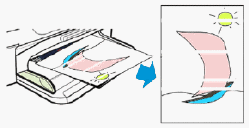
|
Figure : Vertical streaks in printout
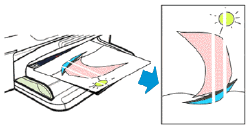
|
|
Continue with the following troubleshooting steps if your printout contains horizontal streaks or other print quality issues besides vertical streaks.
|
Do not replace cartridges for vertical streaks in a printout. Instead, check the paper as described earlier in this document, or search for a document that covers this issue.
|
After trying the preceding guidelines, try printing again.
-
If these steps resolved the issue, you do not need to continue troubleshooting.
-
If the issue persists, continue to the next solution.
Solution four: Check the print settings
Follow these steps to check the print settings to make sure that they are appropriate for your print job.
-
If these steps resolved the issue, you do not need to continue troubleshooting.
-
If the issue persists, continue to the next solution.
Solution five: Check ink levels, and then replace low or empty cartridges
Follow these steps to check the estimated ink levels on your printer, and then replace low or empty cartridges according to the results.
note:Ink level warnings and indicators provide estimates for planning purposes only. When an indicator shows low ink levels, consider having a replacement ink cartridge available to avoid possible printing delays. You do not need to replace ink cartridges until print quality becomes unacceptable.
From the home screen on the printer control panel, touch the Ink Status icon ( ). The control panel displays the estimated ink levels.
). The control panel displays the estimated ink levels.
 ). The control panel displays the estimated ink levels.
). The control panel displays the estimated ink levels.
Figure : Example of estimated ink levels
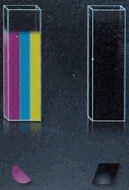
-
If the ink level graphic shows low or empty cartridges, and the quality of your printouts is unsatisfactory, replace the cartridges now. See instructions in this document for how to replace the cartridge.
-
If the ink level graphic shows full cartridges, do not replace the cartridges yet. Continue to the next solution.
Solution six: Print and evaluate a Print Quality Diagnostic report and troubleshoot any defects
Follow these steps to print and evaluate a test page.
Step one: Print a Print Quality Diagnostic report
Follow these steps to print a test page.
-
Load plain white U.S. letter or A4 size paper in the tray.
-
On the printer control panel, touch the Settings icon (
 ).
).
-
Touch Tools, and then touch Print Quality Report. The printer prints the test page.Figure : Example of a Print Quality Diagnostic report with no defects

Step two: Check the Print Quality Diagnostic report for defects
In general, if the printer and its cartridges are working correctly, all the color bars on the test page should be present and unstreaked. The black text should not show ink streaks. The example in the previous step shows a test page with no defects.
Review the following table for examples of defects that can exist on the test page. These examples are not inclusive, but tend to represent the most common issues.
|
Examples of defects on a Print Quality Diagnostic report
|
||
|
Defect
|
Example
|
|
|
Irregular streaks
|
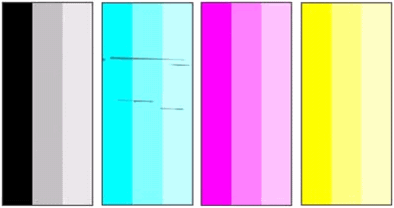
|
|
|
Faded color bars
|
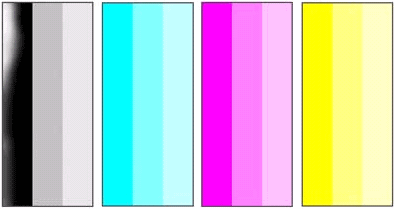
|
|
|
Missing color
|

|
|
|
Color bars with regular white streaks
|
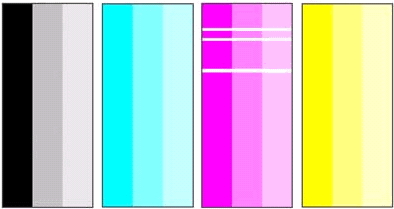
|
|
|
Jagged alignment patterns
|

|
|
-
If you do not see defects on the test page, the print mechanism and ink cartridges work correctly. Do not continue the troubleshooting steps in this document. If printouts are still unsatisfactory, try the following general print quality guidelines.
-
Make sure that the image you are printing has sufficient resolution. Images that are enlarged too much might appear fuzzy or blurry.
-
If the issue is confined to a band near the edge of a printout, use the software you installed with the printer or another software program to rotate the image 180 degrees. The problem might not display on the other end of the printout.
 Windows only: If you are experiencing garbled, jumbled or illogical text, incomplete printouts, or missing text or graphics, go to Continuous Pages of Strange or Garbled Characters Print in Windows
Windows only: If you are experiencing garbled, jumbled or illogical text, incomplete printouts, or missing text or graphics, go to Continuous Pages of Strange or Garbled Characters Print in Windows -
-
If you see one or more of these defects on the test page, continue to the next step.
Step three: Clean the cartridges using an automated tool
note:To avoid issues that require cleaning, always turn the printer off with the Power button.
Follow these steps to run an automated tool to clean the cartridges if you found defects on the diagnostic report.
-
On the printer control panel, touch the Settings icon (
 ).
).
-
Touch Tools, and then touch Clean Cartridges. The printer cleans the cartridges.
-
Try the print job again.
-
If these steps resolved the issue, there is no need to continue troubleshooting.
-
If the issue persists, see the next step.
Step four: Align the All-in-One
Follow these steps to align the printer.
-
Load plain white, U.S. letter or A4 size paper in the paper tray.
-
On the printer control panel, touch the Settings icon (
 ).
).
-
Touch Tools, and then touch Align Printer. An alignment page automatically prints.
-
If these steps resolved the issue, you can stop troubleshooting.
-
If the test page that you printed earlier shows track marks or smears, continue to the next step to clean the area around the ink nozzles.
-
If the test page that you printed earlier does not show track marks or smears, skip to the next solution in this document to replace the problem cartridge.
Step five: Clean the area around the ink nozzles
Complete these steps only if you see track marks or smears in the text on the test page or on your printout.
 Important: Do not perform these steps unless the test page or printout specifically shows smeared text or track marks. If you do not see these defects, continue to the next solution. Important: Do not perform these steps unless the test page or printout specifically shows smeared text or track marks. If you do not see these defects, continue to the next solution.
|
Figure : Example of smeared text

Figure : Example of text with track marks

-
Gather the following materials:
-
Dry foam-rubber swabs, lint-free cloth, or any soft material that does not come apart or leave fibers (coffee filters work well)
-
Clean sheets of paper
-
Distilled, filtered, or bottled water (tap water might contain contaminants that can damage the print cartridges)
caution:
Do not use platen cleaners or alcohol to clean the area. These can damage the cartridge or the printer.
-
-
Press the Power button (
 ) to turn on the printer, if it is not already on.
) to turn on the printer, if it is not already on.
-
Open the scanner lid.
-
Open the cartridge access door. The carriage moves to the center of the printer. Wait until the carriage is idle and silent before continuing.Figure : Open the cartridge access door

-
Lift the cartridge latch to release the cartridge, and then pull the cartridge out of the slot to remove it.Figure : Lift the cartridge latch and remove the cartridge
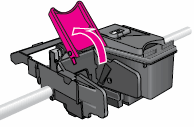
caution:
Do not touch the copper-colored contacts or the ink nozzles on the cartridge. Touching these parts can result in clogs, ink failure, and bad electrical connections. -
Place the cartridge on a piece of paper with the ink nozzles facing up.
-
Lightly moisten a clean, foam-rubber swab with distilled water.
-
Clean the face and edges around the ink nozzle with the swab.
caution:
Do not clean the ink nozzle plate.-
Nozzle plate - DO NOT CLEAN
-
Area surrounding ink nozzle - Do clean
-
Cartridge contacts - DO NOT CLEAN
Figure : Clean the area around the ink nozzle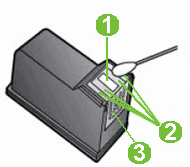
-
-
Either let the cartridge sit for 10 minutes to allow the cleaned area to dry, or use a new swab to dry it.
-
Hold the cartridge at a slight upward angle with the cartridge contacts facing the rear of the printer, and then slide the cartridge into the empty slot.Figure : Reinstall the cartridge

-
Close the cartridge latch to secure the cartridge into place.Figure : Close the cartridge latch
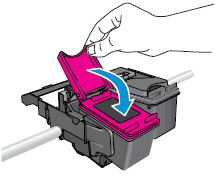
-
Repeat these steps to clean the area surrounding the ink nozzle on the other cartridge.
-
Close the cartridge access door.Figure : Close the cartridge access door

-
Close the scanner lid.
-
Try printing again.
-
If these steps resolved the issue, you do not need to continue troubleshooting.
-
If the issue persists, continue to the next solution.
Solution seven: Replace the problem cartridge
Follow these steps to replace the problem cartridge if you saw defects on the test page and the preceding steps did not resolve the issue, even if the cartridge is not low on ink. The problem cartridge is the one that printed the defects on the test page as described earlier in this document.
If you have a defective cartridge or printhead, it might be under warranty. To check the warranty on your ink or toner supplies, go to Printer and Page Yield Overview, and then review the limited warranty information for your supplies.
-
Press the Power button (
 ) to turn on the printer, if it is not already turned on.
) to turn on the printer, if it is not already turned on.
-
Load a small stack of plain white paper into the paper tray.
-
Open the scanner lid.
-
Open the cartridge access door. The carriage moves to the cartridge access area.Figure : Open the cartridge access door

-
Lift the cartridge latch to release the cartridge, and then remove the cartridge from the slot.Figure : Lift the cartridge latch and remove the cartridge

-
Remove the new cartridge from its packaging, and then pull the pull-tab straight back to remove the plastic tape.Figure : Remove the plastic tape
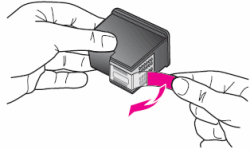
-
Hold the new cartridge at a slight upward angle with the cartridge contacts facing the rear of the printer, and then slide the cartridge into the empty slot.Make sure that the color of the cartridge matches the color on the cartridge lid.
-
The tri-color cartridge goes in the slot on the left.
-
The black cartridge goes in the slot on the right.
Figure : Insert the cartridge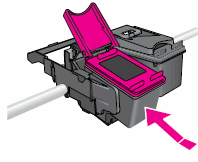
-
-
Close the cartridge latch to secure the cartridge.Figure : Close the cartridge latch

-
If needed, repeat these steps to replace the other cartridge.
-
Close the cartridge access door. The carriage returns to the right side of the printer.Figure : Close the cartridge access door

-
Close the scanner lid.
-
Follow the instructions on the control panel to start the cartridge alignment. The printer aligns the cartridges and prints an alignment page.
-
If these steps resolved the issue, you do not need to continue troubleshooting.
-
If the issue persists, continue to the next solution.
Solution eight: Service the All-in-One
note:Keep a print sample that shows the problem. If the ink cartridges, printhead, or printer is replaced under warranty, the support agent will request the print sample. If the printer is returned to HP, the print sample must be returned with the printer. Place the sample in the output tray when you package your printer for shipping.
Service or replace your HP product if the issue persists after completing all the preceding steps.
Go to Contact HP Customer Support to schedule a product repair or replacement. If you are in Asia Pacific, you will be directed to a local service center in your area.
To confirm your warranty status, go to HP Product Warranty Check. Repair fees might apply for out-of-warranty products.
Enter a topic to search our knowledge library
What can we help you with?
Need Help?

 ) on the Dock, and then click
) on the Dock, and then click  ), touch
), touch 